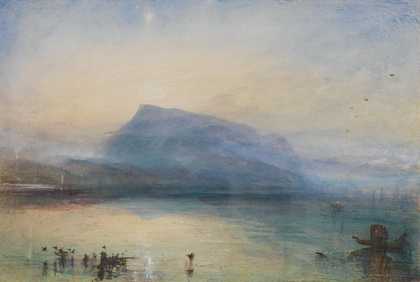
Joseph Mallord William Turner
The Blue Rigi, Sunrise (1842)
Tate
By the time Turner made his four trips to the Swiss resort of Lucerne between 1836 and 1844, it was already a popular destination for the rapidly rising number of European and American tourists. Its placid lake, providing the natural amphitheatre for the steep pine-clad mountains, also attracted writers, musicians and artists who would immerse themselves in the sublime splendours of the natural world. Victor Hugo, Alexandre Dumas, Albert Bierstadt, Brahms and Wagner all revelled in its ethereal and unpredictable beauties. The young elopers Percy Shelley and a 17-year-old Mary Wollstonecraft found temporary tranquillity here in 1814, the latter writing on how the lakes, mountains and forests ‘seemed a fit cradle for a mind aspiring to high adventure and heroic deeds’. Even the humorist Mark Twain couldn’t ignore its sobering effect on the soul, describing the experience of being on Lake Lucerne in his travel satire A Tramp Abroad as ‘the perfection of pleasuring’.
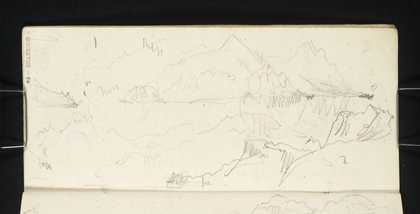
Joseph Mallord William Turner
The Rigi [Turner], Etc., from the Lake (c.1841)
Tate
For many, their eyes were drawn over the glassy turquoise surface of the lake and up the steep hills dotted with farmers’ cottages to the summit of the great Rigi, the ‘Queen of the Mountains’. Some, like Twain and more famously Queen Victoria, would spend many hours navigating the narrow mule tracks to reach the summit (though Victoria was carried up in a sedan chair). Here they could not only enjoy, as one contemporary guidebook put it, ‘a panorama hardly to be equalled in extant and grandeur among the alps for centuries’, but also, for a time, sample the food of celebrity chef Auguste Escoffier at the Rigi-Kulm hotel.
Turner never made it to the top of the Rigi (though he would start on an imaginary scene of the view from the summit, Sunset from the Top of the Rigi c1844), but it provided him with his most repeated and most celebrated subject matter. As well as the dozens of pencil sketches, he would paint more than 30 small watercolour views of the mountain, capturing the effects of the rapidly changing light and weather throughout the day. These included compositional watercolour sketches done in his softback sketching book that could be rolled up and put in his pocket, as well as the more finished ‘sample studies’ (such as The Blue Rigi: Sample Study c1841–2), made for prospective patrons to give an idea of what a ‘completed’ picture might look like.
He observed the Rigi from various places along the lake, but many scenes are from the similar vantage point – possibly from the village of Winkel on the outskirts of Lucerne, or the nearby village of Meggen, a view whose angle gave the mountain a smooth undulating profile. It was from these spots that he would position himself to watch the early morning sun appear from behind the peak, the clouds swirl around the valley, or the mist and rain envelop the whole scene.
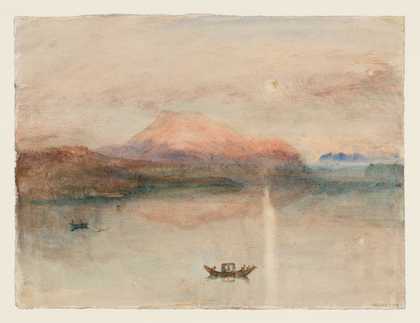
Joseph Mallord William Turner
The Red Rigi: Sample Study (c.1841–2)
Tate
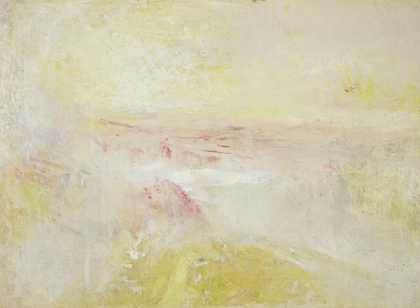
Joseph Mallord William Turner
Sunset From the Top of the Rigi (c.1844)
Tate

Joseph Mallord William Turner
The Pink Rigi (c.1844)
Tate
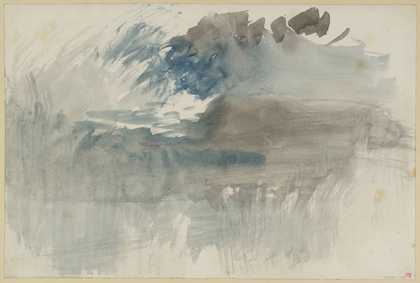
Joseph Mallord William Turner
A Storm over the Rigi (c.1844)
Tate
In these watercolours Turner used the simplest washes of colour. In images so lightly worked they almost disappear, such as The Rigi: Grey and Blue, The Rigi: Rosy Peaks and Clouds and Clouds over the Rigi at Sunrise, from Lucerne, all c1844, the Rigi becomes a delicate haze of colours suspended in space. In A Storm over the Rigi c1844, the tempestuous weather is captured in thick, rapid slashes of blue and black that threaten to obliterate the grey mass of the mountain.
Turner employed a wide range of techniques to get these impressionistic effects – sponging, washing, rubbing, stippling and hatching. And in the more finished ‘sample studies’ he would use a brush with very thin bristles to make his tiny hatch marks to give a more complex depth and body to his scenes. In The Blue Rigi, Sunrise 1842 he created the morning star, or Venus, at the top of the picture by using his ‘eagle clawed’ nail to scratch out the surface to reveal the white of the paper.
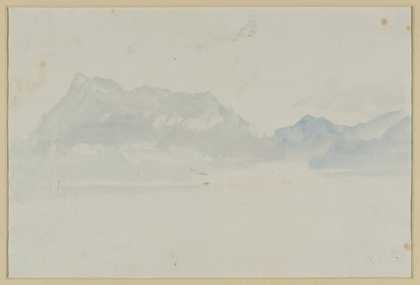
Joseph Mallord William Turner
The Rigi: Grey and Blue (c.1844)
Tate
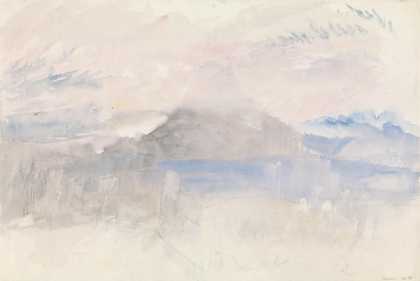
Joseph Mallord William Turner
Cloudy Sunrise behind the Rigi (c.1844)
Tate
John Ruskin, who acquired several of Turner’s late, finished Swiss watercolours, recognised the radical nature of these works, which were, he said, ‘less concerned with the image of the place itself, as the spirit of the place’. But this spirit was not just about the grandeur of nature – it was also about the life within it. We may often consider these watercolours as visual essays in stillness, but in several works Turner depicts the sound of the life that he witnessed. In The Blue Rigi, Sunrise a dog has splashed noisily into the lake, chasing a flock of ducks. In Lake Lucerne from Fluelen (‘The First Steamer on Lake Lucerne’) c1841 fisherfolk are pulling in the nets. You can almost hear their chatter. And in the distant background we can see the tall thin funnel of a steamboat – a symbol of the new industrial age that would transform both the trade and tourism of the area. The first steamboat to appear on Lake Lucerne made its maiden voyage in 1837, and Turner would have undoubtedly made great use of it to travel the length of water in order to gauge every angle of the landscape in front of him. The coal-fired boats would also have provided him with new acoustic sensations – the noisy engines, the manic thrashing of the paddles, the loud ship whistles that echoed around the valley.
Looking at the Rigi and the view it commands today, it is no surprise that it provided Turner with one of his greatest subjects. And what he witnessed will not change. The sun will forever rise behind its peak, the rain will still wash its way over the summit and the clouds will continue to cloak themselves around its imposing bulk.
